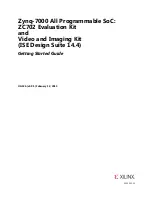
58
Appendix C AES3 Input and Input/Output Boards
Parts Supplied
AES3 input board SC5559 (approx 83mm by 180mm).
AES3 PLL board SC5560 (approx 80mm by 65mm).
AES3 rear blanking panel (approx 40mm by 70mm).
M3 by 6mm screw.
M3 nut.
1 Unplug the unit from the mains supply.
2 Remove the 8 screws holding the lid on and the 8 screws holding the base on.
3 Unplug the 34 way IDC cable from the analogue input board.
4 Remove the three M3 screws and washers holding the analogue input board
into the unit; two at the front on the heatsink and one at the rear on the right.
5 Remove the four plastite screws fixing the input XLRs in place.
6 Remove the analogue input board and store in a safe place along with two of
the plastite screws.
1 Insert the AES3 input board into the unit.
2 Fix the board with the three or four M3 screws and washers that were re-
moved.
3 Put the rear blanking panel over the single input socket and fix using two of
the XLR plastite screws and the M3 nut and bolt supplied with the AES3 input
board.
4 Refit the 34 way IDC cable into the AES3 input board.
1 Put the unit on its side and remove the long M2.5 screw and nut which fix the
small PLL board onto the analogue output board.
2 If there is an earth strap connecting the PLL board to the analogue output
board, unplug it from the large analogue output board.
3 Unplug the small PLL board from the analogue output board. The pins on the
new AES3 PLL board may be protected with a plastic cover or an IC socket. If
so, remove it from the AES3 PLL board and put it onto the pins of the standard
PLL board, removed from the unit, to protect the pins.
1 Plug the larger AES3 PLL board into the analogue output board. The board
should be plugged in with the main part of the AES3 PLL board pointing
toward the front of the unit. Ensure that the pins go in straight and that all pins
are in the socket. Check that the pin 1 marker on the analogue output board
is at the same end as the pin 1 marker on the top of the AES3 PLL board.
2 Replace the long M2.5 screw and nut through the AES3 PLL board and the
analogue output board.
3 Power up the unit, being careful not to touch any of the mains input circuitry,
and check the input board with either a 44.1kHz AES3 input or a 48kHz
AES3 input; the input will automatically sync to whichever clock frequency is
used. If the clock frequency is changed whilst the unit is on, the output of the
unit will mute for a few seconds while locking to the new frequency.
4 Switch off and replace the unit’s lid and base panels.
C.1 Fitting The
AES3 Input Board
Removing the
Analogue Input Board
Plugging in the AES3
Input Board
AES3 Input and Input/Output Boards
Fitting The AES3 Input Board
Plugging in the AES3
PLL Board
Removing the
Standard PLL Board
Содержание Omnidrive FDS-380
Страница 1: ...1...
Страница 64: ...64 User Notes...
Страница 65: ...65 User Notes...
Страница 66: ...66 User Notes...









































